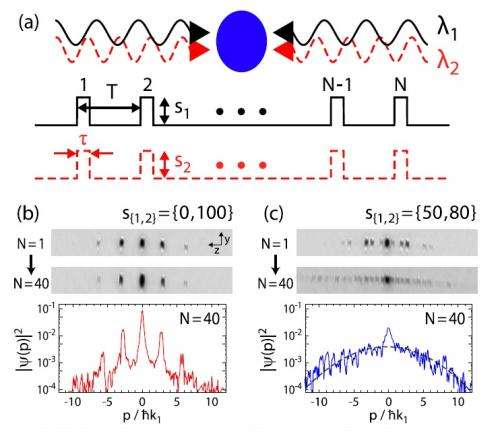May 24, 2013 feature
Experiment investigates how classical physics may emerge from quantum physics

(Phys.org) —In order to better understand how the laws governing the quantum and classical regimes are related to one another, physicists have performed an experiment allowing them to observe a quantum-to-classical transition in a simple closed quantum system. The results suggest that classical behavior may be an innate property of certain isolated quantum systems such as the one studied here, and can emerge from quantum physics under certain conditions.
The physicists, Bryce Gadway, et al., led by Professor Dominik Schneble at Stony Brook University in New York, have published their paper on the quantum-to-classical transition experiment in a recent issue of Physical Review Letters. Gadway is currently at the University of Colorado in Boulder.
"Our results suggest that classical physics may emerge in a very natural way in large quantum systems—in this case, 'large' meaning just two coupled subsystems—without the invocation of an external 'environment' responsible for decoherence," Gadway told Phys.org. "These results are certainly suggestive that classical behavior—specifically diffusive random-walk-like transport at the expected classical rate—is an innate property of this simple, quantum chaotic system."
The scientists' observation confirms a prediction from 1988 by S. Adachi, et al., that classical behavior will emerge in a driven quantum system consisting of two coupled kicked rotors. In the new study, the researchers realized the kicked rotors by "kicking" a macroscopic atomic matter wave (an optically trapped Bose-Einstein condensate) with two periodically pulsed optical lattices. By spacing the pulses a certain way, the researchers could create coupling between the two optical lattices, which act as the rotors.
The physicists found that the system's momentum is affected differently when kicked by two coupled rotors compared with being kicked by a single rotor. Specifically, coupling causes a transition from localization to delocalization. In this context, localization means that the matter wave does not diffuse, or spread. On the other hand, delocalization corresponds to the emergence of classical diffusion, as well as fully chaotic behavior. Essentially, the coupling of the two kicked rotors results in a localization-to-delocalization transition, signaling a quantum-to-classical transition, just as predicted 25 years ago.
Although other demonstrations of quantum-to-classical transitions have been previously reported, the researchers explain that this demonstration is particularly interesting because it occurs in a closed system.

"Thus far, most demonstrations of a quantum-to-classical transition have taken place in open quantum systems, where a purely quantum mechanical subsystem (such as a qubit) is coupled to some macroscopic reservoir, with the end result being decoherence of the pure subsystem," Gadway said. "This is somewhat artificial because it relies on divorcing the reservoir from the system that decoheres; it assumes that information lost to the reservoir will never be returned.
"What we've been able to show is that such quantum-to-classical transitions can emerge even in the dynamics of simple closed quantum systems. By coupling two quantum chaotic subsystems—so-called 'kicked quantum rotors'—they both go from being localized due to destructive interference to displaying diffusive energy transport in a completely classical fashion. This is despite that the fact that all the dynamics are strictly unitary and time-reversible."
In the future, the physicists hope that the experiment can be extended to three or more coupled rotors using additional optical lattices. As Gadway explained, these experiments and others could provide further insight into the transition from localization to delocalization in nonlinear, disordered quantum systems.
"One future line of investigation would be to simply scale this up to coupling three or more quantum kicked rotors, where we expect that the transition to classical behavior may happen for weaker driving and/or weaker rotor-rotor coupling," he said. "We are also looking to couple the external motion of these particles to their internal states (i.e., their spin) to study quantum chaos in 'spinful' systems."
More information: Bryce Gadway, et al. "Evidence for a Quantum-to-Classical Transition in a Pair of Coupled Quantum Rotors." PRL 110, 190401 (2013). DOI: 10.1103/PhysRevLett.110.190401
Professor Dominik Schneble's webpage: Ultracold Physics at Stony Brook University
Journal information: Physical Review Letters
© 2013 Phys.org. All rights reserved.




















